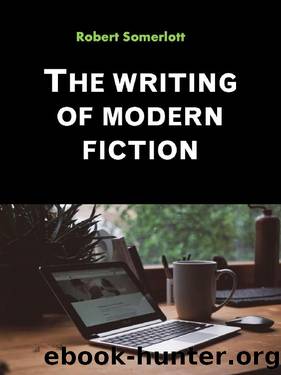The Writing of Modern Fiction by Robert Somerlott

Author:Robert Somerlott [Somerlott, Robert]
Language: eng
Format: epub
ISBN: 9780871160683
Google: OM4bAQAAIAAJ
Amazon: 0871160684
Publisher: The Writer
Published: 1972-01-01T06:00:00+00:00
9
BEWARE THE PAPER DRAGON
JAMES THURBER, in Fables for Our Times, retold the story of Little Red Riding Hood but modernized the ending. The dear girl, seeing the wolf disguised as Grandma in bed, whipped out her pistol and shot the impostor dead. After all, it takes more than a lace nightcap to make a wolf look like your grandmother, and the author points out that âItâs not as easy to fool little girls as it used to be.â
Thurber was also shooting down a time-worn literary device often called a âpaper dragon.â These tissue monsters are traditional and satisfactory in fairy tales; sometimes they work in adult fantasy or broadly humorous pieces. But in todayâs realistic, sophisticated fiction the presence of such a creature is usually fatal.
A paper dragon is a problem, situation, or solution that exists only on paper, never in life. To put it another way, it is something a writer dreams up or fetches from afar for the purpose of writing a story. One example may be worth a dozen definitions:
Richard Davis, a prosperous businessman, married an unattractive woman in the mistaken belief she was rich. Now he and his lovely receptionist are in love, so he plots to eliminate Mrs. Davis by murderously wielding a blunt instrument.
This plot, as it stands, will not pass muster. Has Mr. Davis never heard of divorce? Most people find this a better solution than homicide. Even if the wife opposes such action, prosperous Richard Davis can very likely find a legal way out of his marital misery. The problem, unless we provide a different motive, is not so extreme as the author would have us believe. Given present-day laws and mores, the tale, unless repaired, is a writerâs hoaxâa paper dragon.
Numerous paper dragon subspecies plague writers, but in my experience three distinct varieties are especially common and dangerous to effective fiction.
1. The false note
This is a single, improbable action that happens in the middle of an otherwise valid story. It may arise in any type of fiction, but suspense stories seem to invite this difficulty.
Recently I read a quite good but as yet unpublished romantic novel of suspense, a âgothic.â At one point the heroine descends a dark stairway into the spooky cellars of a chateau. She knows very well that cellars are dangerous, but goes right on, impelled only by curiosity. Since this girl is aware that the dank rooms below are either haunted or dangerous and there is a chance that a fugitive criminal is hiding there, her conduct is idiotic. We realize at once that the writer is moving his character like a chess piece for purposes of plot. The heroine made this foolish descent only on paper, not in reality.
I suspect the writer was so carried away by the suspense he thought he was creating that he never bothered to give the girl a strong motive for rashness. There can be no suspense without believability, and the writer who frequently employs false notes to generate excitement is deceiving only himself, not his readers.
Download
This site does not store any files on its server. We only index and link to content provided by other sites. Please contact the content providers to delete copyright contents if any and email us, we'll remove relevant links or contents immediately.
| African | Anthologies |
| Arthurian | Asian |
| Collections | Dragons |
| European | Greek & Roman |
| Latin American | Mermaids |
| Multicultural | Norse |
| Other | United States |
Quests for Glory by Soman Chainani(6982)
Shadow and Bone by Leigh Bardugo(6512)
Percy Jackson 1 - The Lightning Thief by Riordan Rick(4727)
Siege and Storm by Leigh Bardugo(4685)
The School for Good and Evil #2: A World without Princes by Chainani Soman(4025)
The miraculous journey of Edward Tulane by Kate DiCamillo(3969)
The Dark Prophecy by Rick Riordan(3091)
Quidditch Through the Ages by J.K. Rowling(3005)
Flame in the Mist by Renée Ahdieh(2977)
Cress by Marissa Meyer(2756)
The Little Prince by Antoine de Saint-Exupéry(2739)
Quidditch through the Ages by J. K. Rowling(2704)
Fairy Mom and Me by Sophie Kinsella(2689)
The Tales of Beedle the Bard (Flyboy707Jerry eBooks) by J. K. Rowling(2684)
Quidditch Through The Ages by J. K. Rowling(2676)
Mythology: Timeless Tales of Gods and Heroes by Edith Hamilton & Jim Tierney & Jim Tierney(2672)
The Tales of Beedle the Bard by Rowling J. K(2604)
The Tales of Beedle the Bard by J. K. Rowling(2532)
The Fowl Twins by Eoin Colfer(2519)
